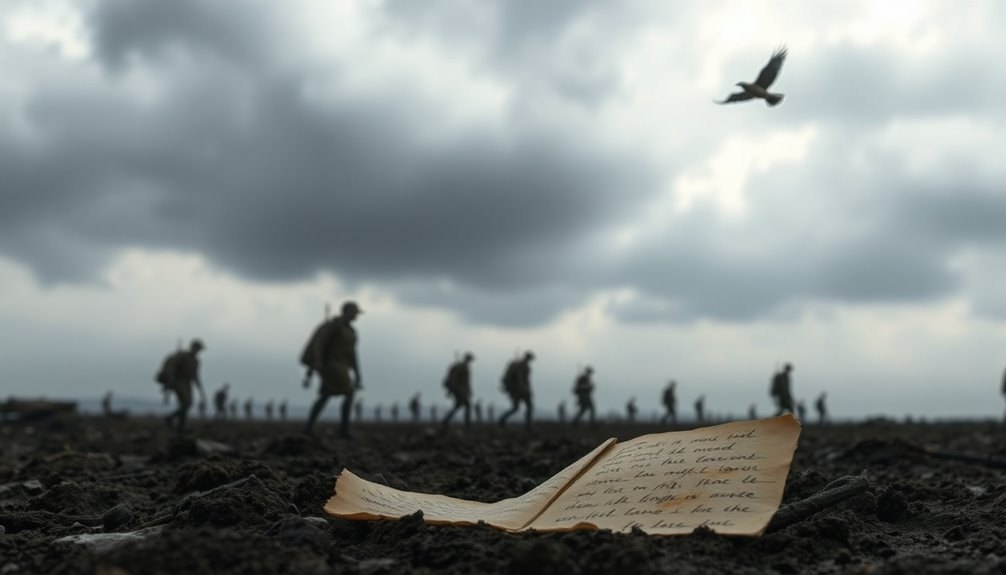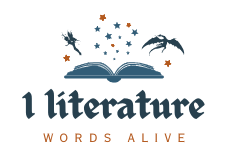In "Birdsong" by Sebastian Faulks, you'll experience a poignant journey through love and war set against the brutal backdrop of World War I. The story revolves around Stephen Wraysford and his affair with Isabelle Azaire, highlighting the tension between personal desire and duty. As you navigate the interconnected timelines of 1910 and 1978, you'll witness how the echoes of love and loss shape generations. Faulks masterfully intertwines intimacy and tragedy, illustrating the resilience of the human spirit amidst chaos. If you keep exploring, you'll uncover deeper themes and insights that resonate across time and place.
Overview of Birdsong
"Birdsong" by Sebastian Faulks is a poignant exploration of love and loss set against the backdrop of World War I. The novel primarily follows Stephen Wraysford, whose turbulent love affair with Isabelle Azaire unfolds in pre-war France.
Faulks masterfully weaves together the emotional depth of their relationship with the harsh realities of war, particularly during the brutal Battle of the Somme. The indiscriminate nature of war, as highlighted in other historical narratives, often leads to a stark juxtaposition between hope and despair in human relationships. The resilience shown by individuals during times of conflict parallels the bravery exhibited by participants in historical resistance movements.
Structured into seven parts, the narrative alternates between the peaceful moments before the war, the harrowing experiences of trench warfare, and reflective post-war life in England. This format emphasizes the lasting impact of conflict on personal relationships and memory, highlighting how love can both flourish and suffer amid chaos.
"Birdsong" stands out as a significant piece of historical fiction, selling over two million copies in the UK alone. Its themes of hope and life resonate deeply, offering readers a glimpse into the human spirit's resilience even in the darkest times. The exploration of resilience amid adversity parallels the struggles faced by characters in other historical narratives, such as those in "The Book Thief."
Author Sebastian Faulks
Sebastian Faulks, the creative mind behind "Birdsong," has made a significant mark on contemporary literature. Born in 1953 in Newbury, England, he was educated at Wellington College and Emmanuel College, Cambridge. His career took off when he served as the first literary editor of The Independent, later becoming the deputy editor of The Sunday Independent.
Faulks is best known for his historical novels, particularly the acclaimed "Birdsong," which explores the complex interplay of love and war during the First World War. The emotional depth portrayed in his characters mirrors the masterful portrayal of the human spirit's resilience found in Dickens' "David Copperfield." In "Birdsong," the harrowing experiences of soldiers reflect the broader societal challenges faced during generational poverty in historical contexts.
In "Birdsong," you'll find deeply developed characters that evoke an emotional connection, making the harsh realities of conflict resonate profoundly. Faulks' ability to weave themes of love amidst the backdrop of war sets his work apart in literature. His experiences living in France enrich his narratives, providing authentic settings that enhance the reader's immersion. This exploration of human emotions during times of strife echoes the themes found in Richard Wright's "Native Son."
Awarded a Commander of the Order of the British Empire (CBE) in 2002, Faulks continues to inspire readers with his compelling storytelling. His exploration of human emotions in times of strife remains a hallmark of his writing, securing his place as a significant figure in modern historical fiction.
Narrative Structure and Themes

In "Birdsong," you'll notice how the narrative shifts between 1910 and 1978, creating a rich tapestry of interconnected stories.
This multi-generational perspective highlights the enduring themes of love and loss, as characters grapple with their relationships amid the chaos of war.
As you explore these temporal shifts, you'll see how Faulks weaves together the personal and the historical, deepening your understanding of the characters' emotional struggles. The complexities of social class and its impact on personal identity resonate through the characters' experiences, much like in Dickens' "Great Expectations." Additionally, the exploration of suburban disillusionment in "Revolutionary Road" parallels the emotional turmoil faced by characters in "Birdsong." The characters' journeys reflect a quest for identity and self-discovery, echoing the transformative experiences found in Pip's story.
Multi-Generational Perspectives
The narrative structure of "Birdsong" masterfully weaves together the lives of two generations, creating a poignant exploration of how war's legacy reverberates through time.
Sebastian Faulks alternates between Stephen Wraysford's harrowing experiences during World War I and the late 1970s reflections of his granddaughter, Elizabeth Benson. This multi-generational approach reveals the profound psychological effects of trauma, as Elizabeth grapples with her desire for independence while uncovering her grandfather's fractured identity shaped by love and loss.
Stephen's passionate affair with Isabelle Azaire before the war haunts him, influencing his experiences as a soldier in the brutal trenches. Faulks uses contrasting narratives to highlight how memories of war continue to shape the identities and relationships of those who come after.
Elizabeth's journey becomes a quest for understanding, as she navigates the complexities of her family's history and the pervasive impact of trauma. Ultimately, "Birdsong" encapsulates the interwoven themes of memory and identity, revealing how love and war shape lives across generations, leaving a profound imprint that lingers long after the last shot is fired.
Interconnected Themes of Love
Exploring the interconnected themes of love within "Birdsong," you see how romantic relationships act as both refuge and source of pain against the backdrop of World War I.
Stephen's passionate love story with Isabelle Azaire unfolds amidst the war's brutality, creating a poignant contrast between the beauty of their connection and the horrors surrounding them. Faulks crafts a narrative that captures the visceral experiences of both love and war, illustrating how deeply intertwined they are.
- The tension between desire and duty complicates Stephen's emotional landscape.
- Isabelle represents both a sanctuary and a painful reminder of loss.
- The graphic portrayal of trench warfare amplifies the stakes of their love.
- Elizabeth Benson's exploration of her grandfather's past highlights love's generational impact.
- The recurring motif of birdsong symbolizes hope amidst despair.
Throughout the narrative, you witness how Faulks illustrates love's resilience in the face of trauma, showing that even in the darkest times, connections can provide solace and a sense of continuity.
This exploration of love's duality enriches your understanding of both the human experience and the profound scars left by war.
Temporal Shifts in Narrative
"Birdsong" unfolds across three distinct temporal sections—pre-war, wartime, and post-war—creating a rich tapestry that intertwines love and loss across generations.
You'll notice how the narrative employs temporal shifts to navigate through the emotional landscapes of its characters. The interwoven timelines highlight the contrasting experiences of Stephen Wraysford during World War I and his granddaughter Elizabeth Benson in the late 1970s. Each section captures different facets of personal identities shaped by the brutality and psychological toll of war.
In the pre-war era, the focus lies on romantic relationships, filled with hope and passion. This beauty starkly contrasts with the grim realities of the wartime chapters, where the impact of war takes center stage, revealing the harrowing legacy left behind.
You'll feel the generational influence as Elizabeth grapples with the shadows of her grandfather's experiences, demonstrating how the past continues to echo in the present. The seamless transitions between these time frames deepen your understanding of how love can persist amidst loss, while simultaneously showcasing the enduring effects of war on individual lives and familial histories.
Characterization and Relationships
Amid the backdrop of love and war, characterizations in "Birdsong" reveal the intricate dynamics of human relationships. You see how Stephen Wraysford's passionate affair with Isabelle Azaire unfolds, marked by admiration and resentment. Their love is complicated, as Isabelle feels trapped in her marriage, showcasing how manipulation influences their emotional turmoil. This complexity mirrors the challenges faced by women in overcoming societal expectations, as explored in various narratives of resilience. Coates' exploration of systemic racism underscores the societal constraints that can pervade relationships, similar to Isabelle's struggles.
As you explore deeper, you encounter Elizabeth Benson, Stephen's granddaughter. Her quest for identity and independence reveals the generational impact of love and war, connecting past and present. The contrast between Azaire's manipulative character and Stephen's romantic ideals further emphasizes the complexities of human connections.
- Stephen's conflict between love and duty shapes his identity.
- Isabelle's struggle illuminates the constraints of societal expectations.
- Azaire's manipulative nature fosters a toxic environment in relationships.
- Elizabeth's journey mirrors her grandfather's emotional battles.
- The interplay of love and loss drives the narrative forward.
Through these characterizations, you grasp the profound impact of love amidst the chaos of war, capturing the essence of human experience. Additionally, the themes of rivalry and ambition in works like "Kane and Abel" resonate with the characters' struggles, emphasizing how ambition can shape destinies in unexpected ways.
Depiction of War

The intricate dynamics of love and relationships in "Birdsong" provide a stark contrast to the harrowing realities of war. Sebastian Faulks masterfully depicts trench warfare, immersing you in the graphic horrors faced by soldiers like Stephen Wraysford during pivotal battles, particularly the First Day of the Battle of the Somme in 1916.
You can almost feel the suffocating atmosphere of the collapsed tunnel where Stephen and miner Jack Firebrace find themselves trapped, embodying the chaos and despair of subterranean warfare. The narrative poignantly reflects on the struggles of marginalized communities who faced similar devastation, emphasizing the broader implications of war on society. The balance between hope and despair is intricately woven into the characters' experiences, capturing the essence of their emotional turmoil amidst chaos.
Faulks doesn't shy away from showcasing the psychological toll of war, illustrating the deep suffering and starvation that haunt the soldiers long after the fighting stops. The narrative intertwines moments of love with the visceral experiences of battle, highlighting how these connections can both uplift and devastate.
You're left to ponder the generational consequences of such trauma, as the identities of those involved are forever altered. In "Birdsong," love and horror coexist, leaving you to grapple with the notion that the scars of war extend far beyond the battlefield, echoing through the lives of those who endure. The themes of social injustice resonate throughout the narrative, mirroring the struggles faced by characters in other literary works.
Ratings and Critical Reception
Despite its challenging themes, "Birdsong" has garnered significant acclaim, reflected in its impressive average rating of 4.11 based on over 80,000 ratings. This strong engagement showcases how readers connect with the novel's emotional depth and historical authenticity.
The book has accumulated 3,997 reviews, often noted for its haunting and thought-provoking portrayal of World War I.
However, critical reception is mixed. While many appreciate the intricate blend of romance intertwined with the horrors of war, some argue that these romantic elements feel unnecessary.
Here are some highlights from the critical reception:
- Emotional Depth: Readers frequently mention the profound impact of Faulks's writing.
- Historical Authenticity: The detailed research enriches the narrative.
- Literary Awards: "Birdsong" has won multiple accolades, affirming its significance in contemporary British literature.
- Moving Prose: Faulks's rich language captivates and engages.
- Controversial Pacing: Some critiques focus on the book's narrative pacing.
Historical Context

Acclaim for "Birdsong" often stems from its rich historical context, which immerses readers in the harrowing realities of World War I. You follow the protagonist, Stephen Wraysford, through the brutal landscape of trench warfare, particularly during the significant Battle of the Somme in 1916.
Faulks expertly intertwines real historical events with fictional narratives, providing an authentic glimpse into the lives of British soldiers and the civilians affected by the conflict.
As you read, you can't help but notice the societal changes that shape the early 20th century. The stark contrast between pre-war life in France and the grim realities of war highlights the trauma experienced by those on the frontlines and their families.
The narrative doesn't just focus on the immediate impact of war; it also spans generations, linking the traumatic experiences of WWI veterans to descendants like Elizabeth Benson in the late 1970s. This connection emphasizes the long-term effects of war on family histories and the collective memory that endures.
Ultimately, "Birdsong" serves as a poignant reminder of how trauma shapes lives and the quest for understanding amidst personal and historical upheaval.
Symbolism and Motifs
In "Birdsong," symbols and motifs intertwine seamlessly to deepen your understanding of the characters' struggles and the broader themes of war. The recurring imagery of birds encapsulates both freedom and fear for Stephen Wraysford, mirroring his internal conflicts as he grapples with the juxtaposition of life and death. Faulks uses vivid descriptions and premonitions in the 1910 sections to foreshadow the psychological impact of impending horrors on the characters.
- The body symbolizes both vulnerability and strength, with love scenes echoing the intensity of battle.
- Nature serves as a stark contrast to the brutality of war, offering moments of beauty and peace amid chaos.
- Elizabeth's character embodies the cyclical nature of history, linking her present to the past through the generational impact of trauma.
- The motifs of love and loss underscore the profound connections forged and shattered by war.
- Faulks' exploration of these themes highlights the visceral nature of human experiences, revealing how love can exist alongside destruction.
Through these symbols and motifs, you gain a richer perspective on the emotional landscape of "Birdsong," grappling with the complexities of love and the scars of war.
Community Engagement and Discussions

Many readers find themselves deeply engaged in discussions about "Birdsong," drawn in by its emotional depth and historical context. As you explore Sebastian Faulks's narrative, the themes of love and war ignite passionate community dialogue.
With an impressive average rating of 4.11, the book's character development resonates with many, encouraging you to examine the profound emotional connections between Stephen Wraysford and Elizabeth's experiences across generations.
In book clubs, you often hear varying perspectives, especially regarding the intergenerational narrative that highlights trauma and memory. Readers share how Faulks's storytelling evokes strong feelings, prompting deep reflections on the impacts of war.
While mixed reviews arise concerning the prose and pacing, these discussions only enrich your understanding of the text, revealing diverse interpretations of the characters' journeys.
As you engage in these conversations, you realize that "Birdsong" isn't just a story; it's a catalyst for examining the human experience amidst conflict.
The ongoing dialogue within your community reflects how this powerful novel continues to resonate, leaving a lasting imprint on your hearts and minds.
Conclusion
In "Birdsong," Faulks weaves a poignant tapestry of love and loss, reminding us that the echoes of war resonate through the heart. You've witnessed how the characters navigate their turbulent fates, painted against the backdrop of conflict. As you close the book, you realize that beneath the harshest realities lies an enduring spirit of hope and connection, like a fragile bird finding its way home through the darkest storms. This tale lingers, inviting deeper reflection long after the final page.



